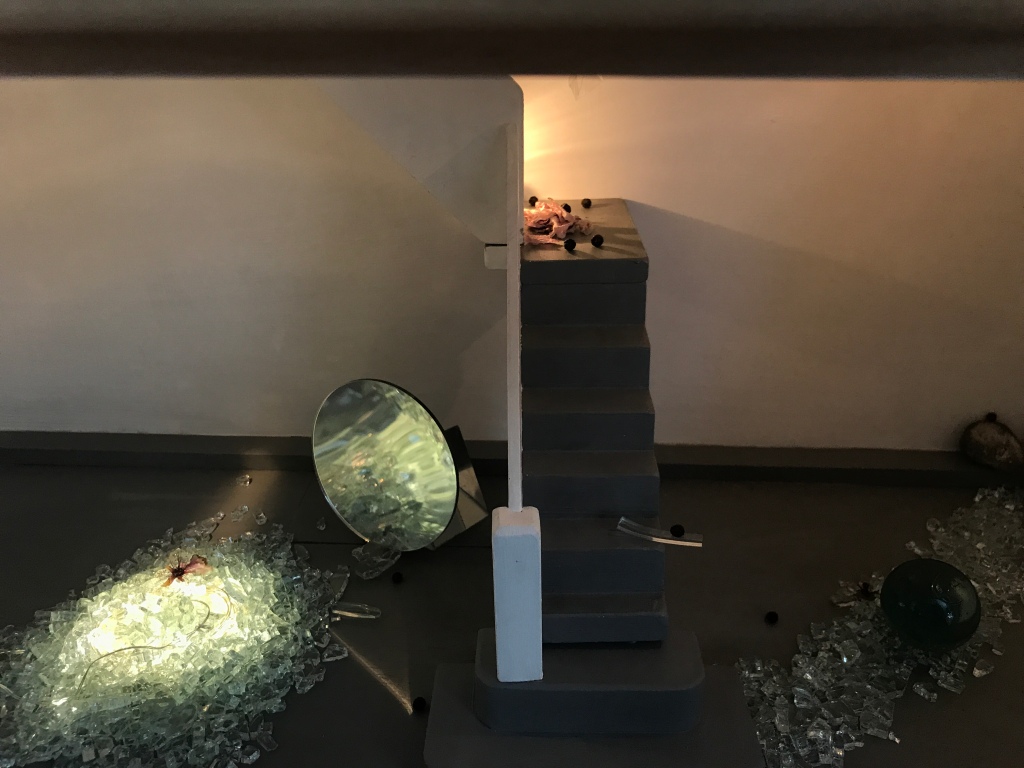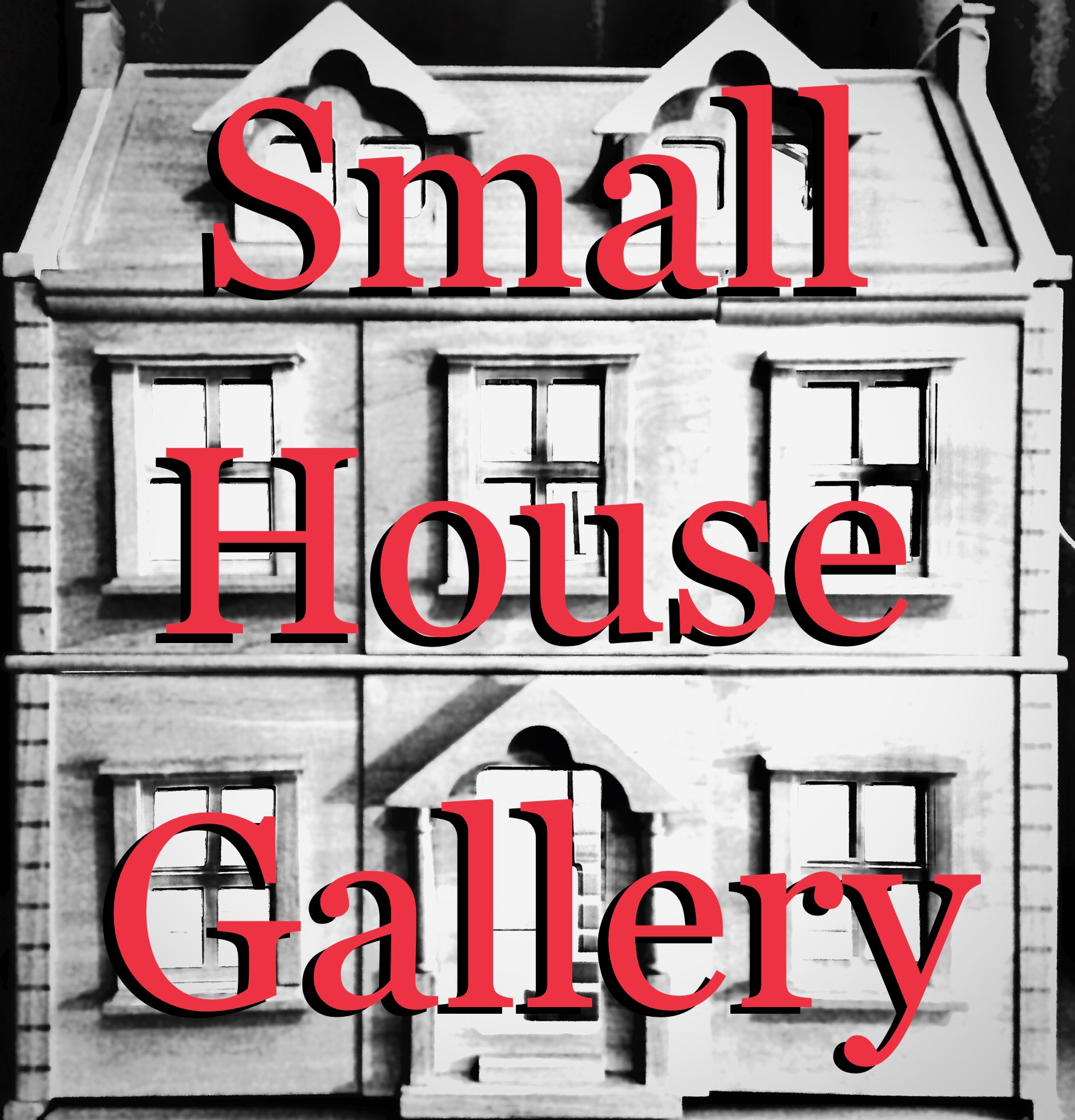“As an artist, I am fascinated by the duality of life and death, the fleeting nature of time, and the fragility of memory. My latest site-specific installation, located inside a doll’s house, is a reflection of these themes. Using a combination of light, shattered glass, mirrors, old house keys, thread, glass marbles, copper (tubing, steel) wire, tiny flowers, (rose) petals, black pepper, (catkins, flint, and oyster shell), I have created a space that explores the ephemeral and the eternal, the broken and the whole.”


Upon entering the gallery on the ground floor, we are greeted by a luminescent pile of shattered glass, lit from within, coexisting with a concave mirror bouncing the installation back towards the eye, to show multiple other magnified and warped viewpoints at once. A delicate tiny flower sits a-top the little mound of clear glowing shards, a gently glittering hill of glass suggesting fleeting visual possibilities of meanings. The jagged fragments sparkle and glimmer in the soft lighting, casting a warm, quiet, calm, and contained glow.



As we move through the space, we are confronted by a series of happenings, setups and tableaux: “Thinking about their relationship with each other, floor by floor, I see them as binaries, bouncing off each other, coexisting… playing with symbolic gestures using mirrors, and the idea of the circle and spheres, the glass marble balls, the tiny black balls (of black pepper)scattered around , (I’ve been) playing with the (contrasts) of black and white, light and dark, shadows and light, and responding to the space playfully.”


The antique life-sized house keys represent the idea of home and security. They serve as a reminder of the past and invite the viewer to contemplate the meaning of safety, stability, and belonging. But they also represent loss and the impermanence of material things.
“I lost both my parents over these past few years, and this is my first work exploring that space of loss, time, memory and the fragility of life.”


At the heart of the gallery, we find another intervention sculpted in light, tumbling from the top floor, suggesting a flowing energy field that transforms itself into a more solid presence. A ‘live wire’ slides down through a piece of copper tubing into a jumble of solid steel wire coil resembling a three dimensional graphite drawing of a cloud, an emotion – a metallic feeling. This little sculpture is cold, yet expressive, playing across positive and negative space. “I see this light as an animation; the use of a mirror comes back to show other angles and viewpoints, playing with the possibilities of different perspectives and surrealism. The light arrives above and seems to dance into the space, creating a sculptural performative act.”
“It reminds me that beauty and wonder can be found even amid loss and a feeling of chaos and dislocation.”
This tiny installation explores themes of fragmentation, reflection, and the transitory nature of light. It’s asking questions about the interplay between our sensitivity to changes in light, our psychological perception of time, and our emotional experience of space.
Is the space in the rooms holding time? How much time is contained within each space? How are the various light sources functioning inside the house (daylight, streetlights through the windows at night, the various lights in the room the gallery is in, the dolls’ house lights, the LED fairy lights)? What do we think the subtle shadows are defining and marking in those spaces? How does the passing of night to day, and day to night affect each area? Do we perceive them differently? Do we encounter experience of the installations differently depending on the time of day? (or of our lives) What about the time we live in? The time we believe we are at, or have left, in our individual lifetime? The time we have left in a day? Or time as we perceive it, and behold it? How do these things affect how we receive the collection of experiences we are offered on a daily basis?


As the gaze moves through the space, it encounters a range of site-specific installations that are unique to the physical architecture of the dolls’ house. Mirrors and glass spheres, the light moving across the room, seem to arrive suspended from the ceiling, casting subtly fractured shadows and a surreally ethereal effect on the floors.
The glass marble and balls of string sculptures on the third floor are delicate but solid and simple in their form, evoking the fragility and strength of motherhood and the transience of life, when self as mother becomes challenged by the other/the child.


A tiny speck of green light shimmers from within the shadow of this sculpture, and that little speck of green, bright light matters. It must exist there, in that place.

Throughout the exhibition, there is a physical exploration of play, memory and beholding a sense of duality and temporality. The glass and mirror installations are simultaneously beautiful and uncanny, reflecting the delicate balance between life and death. Using black pepper added another layer of complexity, evoking memories of the domestic, the recognisable and the unrecognisable while also reminding me of the fleeting nature of time.
The shattered glass, arranged in intricate patterns and shapes, serves as a metaphor for the fragments of time. Each piece of glass represents a moment, a memory, a fragment of a life lived. The play of light on the glass creates a dynamic and ever-changing surface reflecting life’s transience and the inevitability of change.



The glass marbles, copper wire, and thread sculptures represent the delicate and ephemeral nature of life. They are fragile and soft, like the petals of flowers, and they invite the viewer to contemplate the beauty and fragility of existence. The domestic interwoven by the use of old keys, the thread, and the tiny dolls house chair that seemingly appears to be resting on the ground, but as your gaze spends longer, you suddenly notice that what seemed stable is thrown gently off by a piece of black pepper that sits underneath one of the front chair legs. What we assume to see when we glance quickly suddenly reveals a different visual reading and meaning, playing with our assumptions of looking and the time we spend seeing to actually notice what is happening in front of us in that environment.
Black pepper, scattered throughout the installation, serves as a reminder of the fragility of life and the inevitability of death. It represents the passage of time, the decay of the body, and the transience of all things.
Together, these elements create a space that is both beautiful and haunting. It reflects the dualities of life, the temporality of existence, and the fragility of memory.
“Through this installation, I invite the viewer to contemplate the fleeting nature of time, the transience of all things, and the beauty that can be found in the broken and the ephemeral.”

In lieu of a bio, hear Florencia talking about her background in the clip below (from her RCA days).
She defines her work thus: “My fine art photography is very theatrical. It’s very stage-based; it takes place in a studio, and I create performances for the camera.”
One thing Florencia does not mention in this video clip (and that is because it came afterwards) is the high-end art consultancy work she became known for, and which slotted in so perfectly with raising her family. As is usually the case with artist-mothers/mother-artists, our own art making energies get funnelled into the crucial role and tasks involved in child rearing, and kids cost money to raise, so maintaining a viable career as a working artist when the children are a certain age is not really a practical option for most artist-parents, especially artist-mothers.
Once an artist, always an artist! And like she says in the video: “Whatever you do, it’s gonna, at the end, come together. … I don’t think to limit yourself by having to choose, I think everything can be done, everything is possible – you can be a chef and you can be an artist and you can be a writer, and you can still be a mother. … and it’s gonna take me time to fine tune, and I’m in that process, and … I think the main thing is I just have to be patient…”
Her fans will have been patient too, and that patience will, no doubt, be well rewarded. Now that her children are older, we will almost certainly start to see more and more from this stellar creator. Small House Gallery is a perfect testing ground and showcase for her playful, low-stakes re-entry into the art world (on the professional art-making side of things, that is). We are honoured to be the stepping stone right on the threshold to the way back ‘in’.

Leave a comment